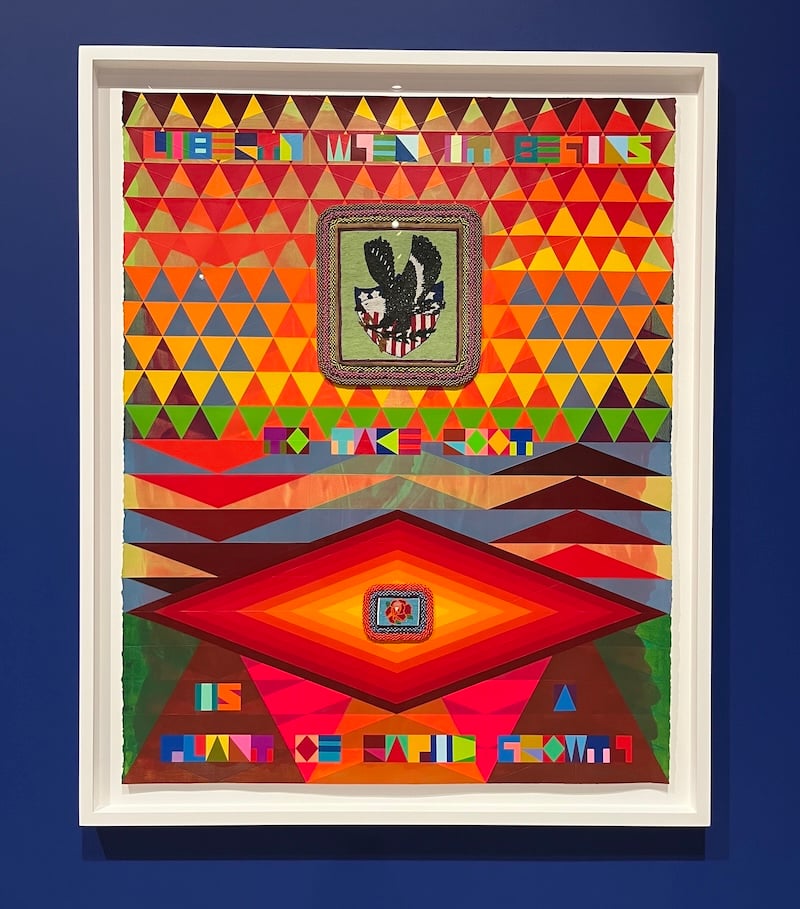ARTchivist's Notebook: A moment of joy
Indigenous artist Jeffrey Gibson activates the archives with joy, compassion, and color vibration!

I just went to see Jeffrey Gibson: the space in which to place me at the Broad Museum here in Los Angeles, and it is an absolute balm for the moment we in the U.S. find ourselves in, with ongoing attacks on our humanity, civil rights, and freedom of expression. While it feels like the range of what is safe to do, say, and be is growing ever more constricted, Gibson’s work is an expansive missive of love.
The artist, who is of Choctaw and Cherokee descent, delves into the archives to embed stirring quotes and Indigenous beadwork into riotously colored, geometric abstractions that pulse and vibrate so hypnotically, you can feel them in your bones. The quotes he chooses come from all manner of sources—the U.S. founding fathers, speeches by Martin Luther King, Jr., lines from pop songs by Tracy Chapman and Roberta Flack. Gibson inscribes these words in blocky, multicolored lettering so that they flicker in and out of recognition: not quite subliminal but not easy to read, either. The words almost blend into the pulsing patterns behind them; the process of seeking and deciphering makes understanding feel hard won. The messages feel that much more precious, but also fragile: always just a bit out of reach.
The phrase in the work above, “LIBERTY WHEN IT BEGINS TO TAKE ROOT IS A PLANT OF RAPID GROWTH,” is from a letter George Washington wrote to James Madison in 1788. It feels particularly relevant in this moment, as we see so many liberties being taken away. It's also hopeful, reminding us that freedom, when we continue to exercise it, has the power to rapidly spread. It’s also ironic that Gibson, an Indigenous artist, should find this truth in the words of Washington, who despite fighting for freedom from British colonial rule, was also an enslaver.
Gibson has also embedded Indigenous beadwork by other artists into this piece, and it is another irony that the uppermost example depicts a bald eagle in front of a crest patterned like the American flag. That an Indigenous artist created this image celebrating the country that dispossessed all Native American peoples reveals another truth: the story of U.S. conquest is tangled and complex. The nation and culture we have all inherited as a result of this original violation (which goes hand in hand with slavery) belongs to all of us, not just to those who anoint themselves the victors. We are entitled to plant our own versions of history and to see them, like liberty, rapidly grow.
This inclusive ethos runs through all of the work on view. In another room is a nine-channel video of Sarah Ortegon HighWalking (Eastern Shoshone and Northern Arapaho) dancing to a pulsing EDM song by First Nations group, the Halluci Nation, and wearing various jingle dresses of her own making. Gibson has repeated and refracted her image over and over in a kaleidoscopic manner so that the screen appears to vibrate with her movement and energy. When I walked into the darkened gallery, someone was dancing along in the back of the room. That's not something I see very often in a museum!
I love how Gibson’s work activates the archives and brings other Indigenous artists along with him into the museum. It responds to a shared American heritage forged in violence and pain within a context of oneness and compassion, without looking away or sugar coating things. In this moment in which that violence and pain is being more forcefully asserted again, it shows us how to keep going–with love.
News & opportunities
History repeating
I wrote an opinion piece for Hyperallergic connecting the ICE raids in Los Angeles to the incarceration of my Japanese American family during WWII. This moment, like that historic one, not only causes great pain and suffering, but creates reverberations that future generations will be dealing with for a long time.
Celebrating criticism and supporting the next generation
Happy to announce the winners of the Irene Yamamoto Arts Writers Fellowship! Congratulations to Heven Haile and Joyce Kwon! And for the first time, a special juror’s recognition to Syd Westley! So grateful to be able to support these emerging music critics of color.
The screening of “Out of the Picture” and panel of cultural critics that I helped organize with the Democracy Center at the Japanese American National Museum was postponed due to the military incursion and curfew imposed on downtown L.A. last month. It has now been rescheduled for Sept. 11. If you'll be in LA, you can get your tickets now.
Indigenous collections care & name authorities
The Assocation of Tribal Archives, Libraries, and Museums (ATALM) is offering a 3-day “Caring for Indigenous Collections Institute” in conjunction with the 2025 International Conference of Indigenous Archives, Libraries, and Museums in Cherokee, NC Oct. 7-9. Scholarships are available for applicants with financial need. Deadline for applications is July 15.
SNAC (Social Networks and Archival Context) is hosting two “Indigenize SNAC” workshops to instruct attendees in using SNAC for Indigenous research and reference (July 16) and for those interested in editing SNAC (August 6 & 7). Learn more & register here.
Fighting erasure in Palestine & Lebanon
Archives and Heritage for Palestine presents a conversation on the Fighting Erasure project and Lebanese cultural memory, Saturday, July 12, 2025. Fighting Erasure: Digitizing Gaza's Genocide and the War on Lebanon documents and protects indigenous land, built environments, archives, and heritage in Gaza and elsewhere in Palestine, as well as in South Lebanon and the surrounding areas. Speakers Dr. Habib Sadek, Maryam Hariri, Amani Rammal & Fatima el-Bazzal will be in conversation with Shatha Hanayshe to discuss this important and urgent work.